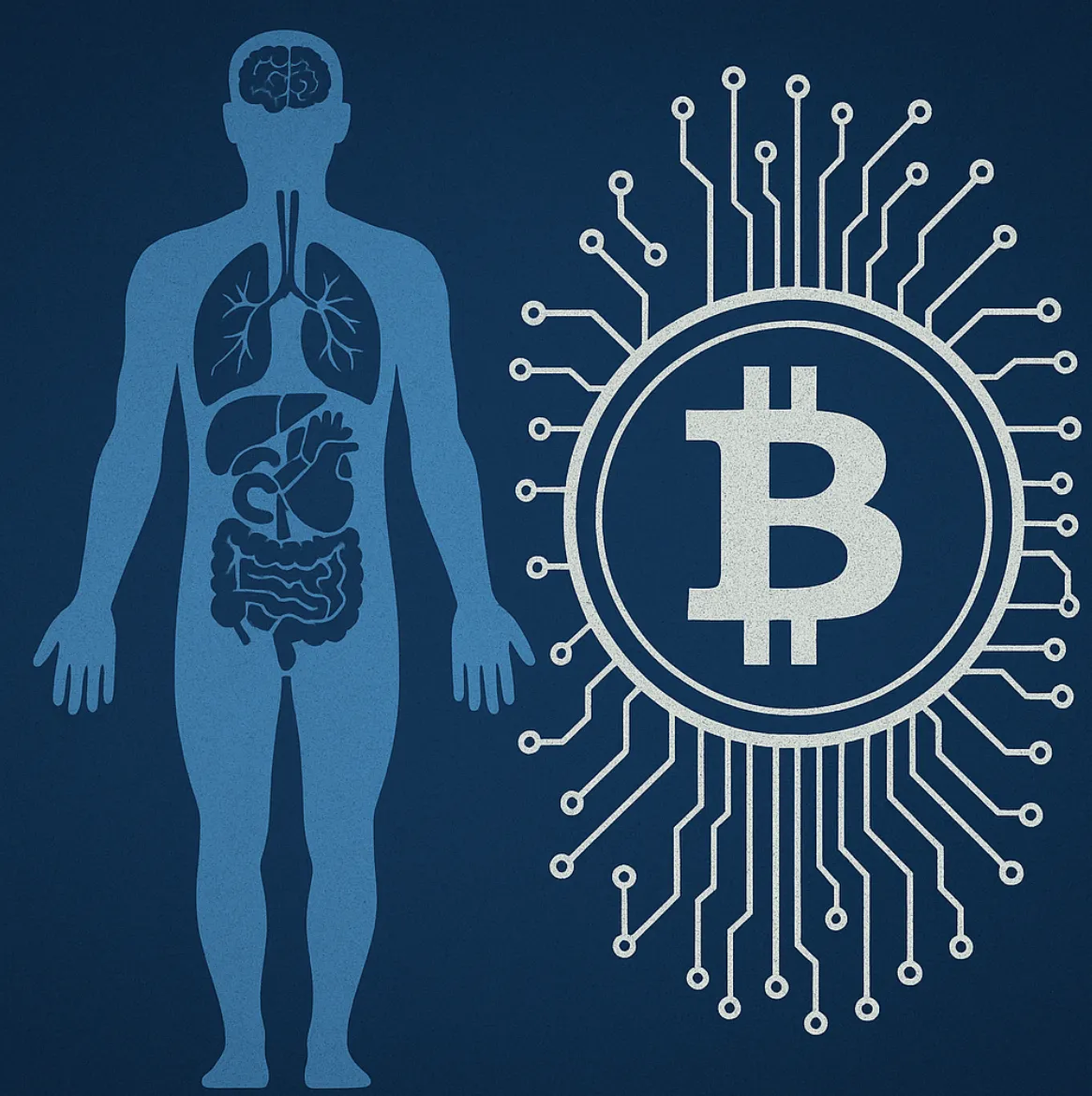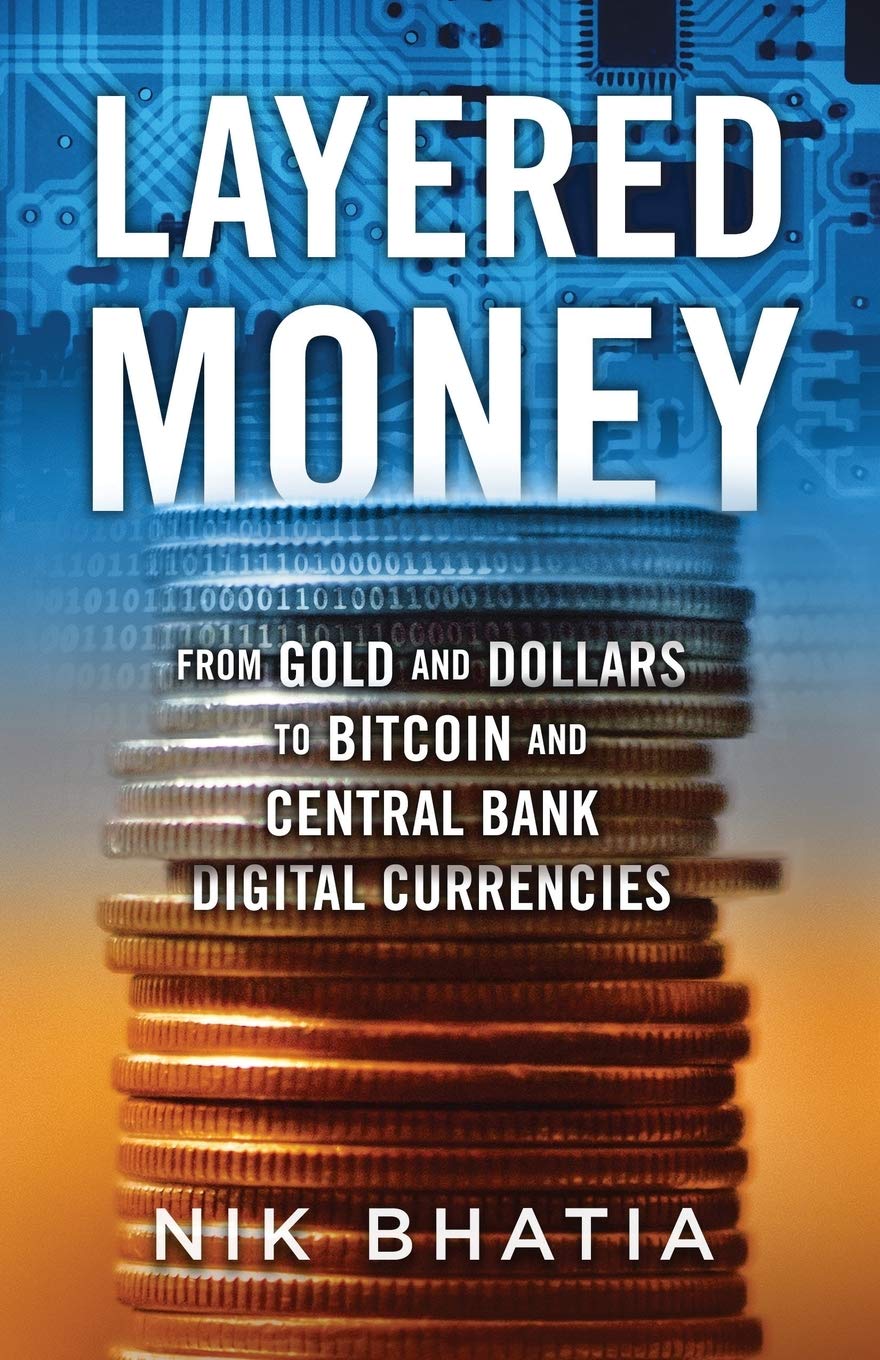BITCOIN AS
SOUND MONEY
BITCOIN AS
SOUND MONEY
Explore how Bitcoin restores financial integrity with fixed supply, decentralization, and resistance to inflation. This resource breaks down why Bitcoin isn’t just digital currency—it’s the foundation for a more stable, honest monetary future.

"Bitcoin fixes the root of economic instability: money that loses value over time.”
– Saifedean Ammous

"Bitcoin fixes the root of economic instability: money that loses value over time.”
– Saifedean Ammous
Featured

Bitcoin Physiology: How the Network Mirrors a Human Body
Bitcoin isn’t just code. It behaves like a living organism—processing energy, circulating information, defending against threats, and adapting over time. To see it clearly, let’s map Bitcoin’s moving parts to human anatomy, and along the way break down the complex acronyms and processes that make this living protocol tick.
Skeleton & Muscles → Hardware and Hashrate
In the human body, bones provide structure while muscles generate force. Bitcoin mirrors this division.
Bones (nodes): Bitcoin nodes are computers running the Bitcoin Core software. They store the entire blockchain (the full history of transactions) and enforce consensus rules. This is the skeleton—without it, there’s no structure or alignment.
Muscles (miners): The muscles are Application-Specific Integrated Circuits (ASICs), specialized chips engineered solely for calculating SHA-256 (the cryptographic hash function Bitcoin uses). Just like contracting muscle fibers, ASICs perform trillions of hash calculations per second, giving Bitcoin its “hashrate.”
Hashrate explained: This is a measure of how many guesses miners can make per second to solve Bitcoin’s Proof-of-Work (PoW) puzzle. A hash is the output of a cryptographic function that transforms any input into a fixed-size string. The higher the hashrate, the more “muscle power” is securing the network.
Heartbeat & Blood Flow → Block Interval & Transaction Circulation
The human heart beats about once per second. Bitcoin’s “heart” beats about once every ten minutes.
Heartbeat (blocks): Bitcoin’s heart is the discovery of a new block. On average, one block is mined every 600 seconds. This rate is not precise, because block discovery is a Poisson process, meaning events occur at random intervals but average out over time.
Blood (transactions): Transactions waiting to be confirmed live in the mempool (short for memory pool). Think of it as venous blood waiting to pass through the heart. When miners include transactions in a block, they become “oxygenated” and are pumped through the network as confirmed, spendable UTXOs (Unspent Transaction Outputs).
UTXOs explained: Unlike a bank balance that changes in place, Bitcoin uses UTXOs. Each transaction consumes earlier UTXOs and creates new ones, like cells exchanging oxygen.
Lungs & Gas Exchange → Propagation & Compact Blocks
Breathing keeps oxygen moving into the bloodstream and carbon dioxide moving out. Bitcoin’s “lungs” are the peer-to-peer network that breathes in transactions and exhales blocks.
Alveoli (compact blocks): Tiny air sacs called alveoli maximize surface area for gas exchange. Similarly, BIP152 Compact Blocks reduce bandwidth by transmitting short transaction IDs instead of the entire transaction. This allows nodes to reconstruct blocks quickly, minimizing latency.
Hemoglobin (Merkle trees): Just as hemoglobin molecules carry oxygen by binding to it, Bitcoin’s Merkle trees bind transactions together into one compact fingerprint called the Merkle root. This single hash goes into the block header, ensuring the integrity of every transaction inside.

Metabolism & Mitochondria → Proof-of-Work
Cells stay alive because mitochondria convert nutrients into ATP (adenosine triphosphate), the body’s energy currency. Bitcoin stays alive because miners convert electricity into Proof-of-Work.
PoW explained: To mine a block, miners must find a hash of the block header that is below a given target number. This target is adjusted by difficulty (see below). The process is computationally expensive, like cellular respiration, and prevents anyone from cheaply faking a block.
Security budget: The “energy burn” is intentional. Just as metabolism keeps you alive by resisting entropy, PoW ensures attackers would need enormous energy to outpace honest miners.
Homeostasis → Difficulty Adjustment
Human bodies regulate internal states—temperature, blood pressure, pH—through feedback loops. Bitcoin does the same with difficulty adjustment.
Mechanism: Every 2016 blocks (roughly 2 weeks), the network looks at how long those blocks actually took. If blocks came too fast, difficulty increases; if too slow, difficulty decreases. This negative feedback loop keeps block production stable at ~10 minutes, even if hashrate suddenly doubles or halves.
Nervous System → Gossip, Validation, and Reflex Arcs
Your nervous system transmits electrical signals without a central bottleneck. Bitcoin nodes communicate in a similar decentralized way.
Gossip protocol: Nodes relay information peer-to-peer using messages like
inv(inventory),tx(transaction), andblock(block). This is gossip—fast, redundant, and distributed.Reflex arcs: Just as reflexes bypass the brain for speed, nodes validate transactions locally before relaying. Invalid data is never propagated, protecting the system from overload.
Myelin: Header-first sync and compact relay are like myelin sheaths on neurons—speeding up the signal while reducing waste.
Endocrine System → Fees, Subsidy, and Halvings
Hormones regulate short- and long-term processes. Bitcoin’s “hormones” are incentives.
Fees: When blocks are full, fees spike. This is adrenaline—the system prioritizing urgent payments. Techniques like RBF (Replace-By-Fee) or CPFP (Child-Pays-For-Parent) act like emergency hormonal boosts.
Subsidy and Halvings: Every ~210,000 blocks (about 4 years), the block subsidy halves. This is long-term hormonal development, akin to puberty or aging. Early on, miners were fueled mostly by subsidies (newly issued bitcoin), but over time, fees will dominate.
Immune System → Consensus Rules & Adversary Resistance
Your immune system protects against pathogens. Bitcoin’s consensus rules protect against invalid activity.
Innate immunity: Every node rejects blocks or transactions that break the rules (wrong signatures, overspending, oversized blocks). This is like skin and stomach acid blocking pathogens.
Adaptive immunity: Over time, upgrades like SegWit (Segregated Witness, which fixed transaction malleability) or Taproot (enhancing privacy and efficiency) refine defenses. These are like new antibodies acquired after exposure.
Watchtowers: In the Lightning Network, watchtowers monitor for cheating attempts and penalize offenders. This is like immune surveillance—seeking out and eliminating rogue cells.
Digestive & Waste Systems → Pruning, UTXO Hygiene, and Reorgs
Bodies manage waste; Bitcoin does too.
Pruned nodes: Just as your liver filters toxins, pruned nodes discard old block data while keeping the essential UTXO set.
UTXO consolidation: Wallets combine small outputs into larger ones when fees are cheap, like nutrient recycling for efficiency.
Reorgs: Occasionally, two miners find a block at the same time, creating a short “chain split.” The network reorganizes (choosing the chain with the most cumulative work). Small reorgs are like routine cell turnover; large ones would be pathological.
Peripheral Nervous System → Lightning Network
Your body doesn’t route every signal through the brain; reflexes handle quick responses. Similarly, not every Bitcoin payment needs the blockchain.
Lightning channels: Two participants lock funds in a 2-of-2 multisig on Bitcoin’s base layer. From there, they can transact instantly off-chain.
HTLCs explained: Hashed Timelock Contracts ensure conditional payments. You reveal a secret (the preimage) within a deadline (timelock), or the funds return. This guarantees atomic routing across many nodes.
Onion routing (privacy): Like a message wrapped in layers, each Lightning hop only knows where the payment came from and where it goes next—never the full route.
Growth & Development → Taproot and Evolution
Organisms mature by adding complexity while conserving DNA. Bitcoin evolves through carefully designed upgrades.
Taproot: Introduced Schnorr signatures and Merklized Abstract Syntax Trees (MAST). In practice, this means multisig and complex scripts look indistinguishable from simple payments, boosting privacy and efficiency.
Soft forks vs. Hard forks: A soft fork is like a genetic mutation that tightens rules but remains compatible with old ones. A hard fork is speciation—a split into a new organism altogether.
Why This Matters
Both biology and Bitcoin endure by solving the same problem: how to persist in a hostile environment. Energy costs enforce scarcity. Feedback loops preserve stability. Local autonomy makes the system resilient. Evolution—whether by antibodies or soft forks—adapts to new threats.
Bitcoin is not “just software.” Like a body, it is an emergent organism of energy, matter, and information—built to survive.
Shout-out to BullishBTC.com.
Bitcoin: The Perfect Solution to Broken Money
The Stories We Tell About Money
The Bitcoin Standard | Saifedean Ammous
True Cost of Inflation | Michael Saylor and Lex Fridman
Explained: What Is Sound Money?
Escaping the Global Banking Cartel - Bitcoin as an Exit
No More Inflation | Why Everything Gets More Expensive & What We Can Do About It
Hard Money - WTF Happened in 1971?
OUR GOAL
Our goal is to educate others on the value of owning Bitcoin from both a financial and humanitarian perspective.
QUICK LINKS
© 2025, BullishBTC. All rights reserved.







